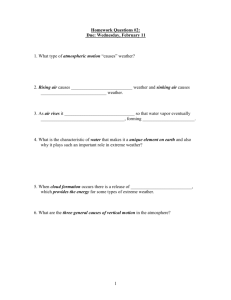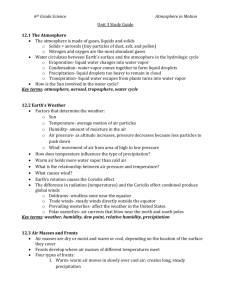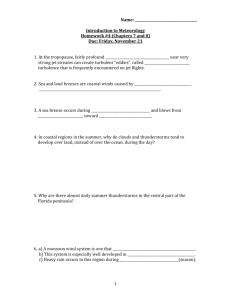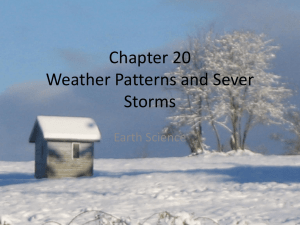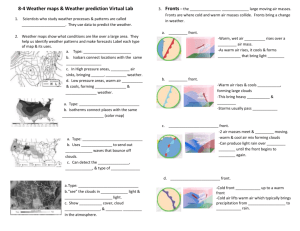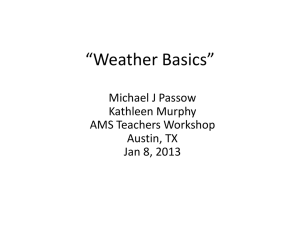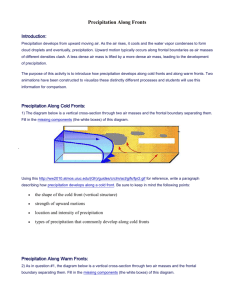Homework Questions #2: Answers 1. What type of atmospheric
advertisement
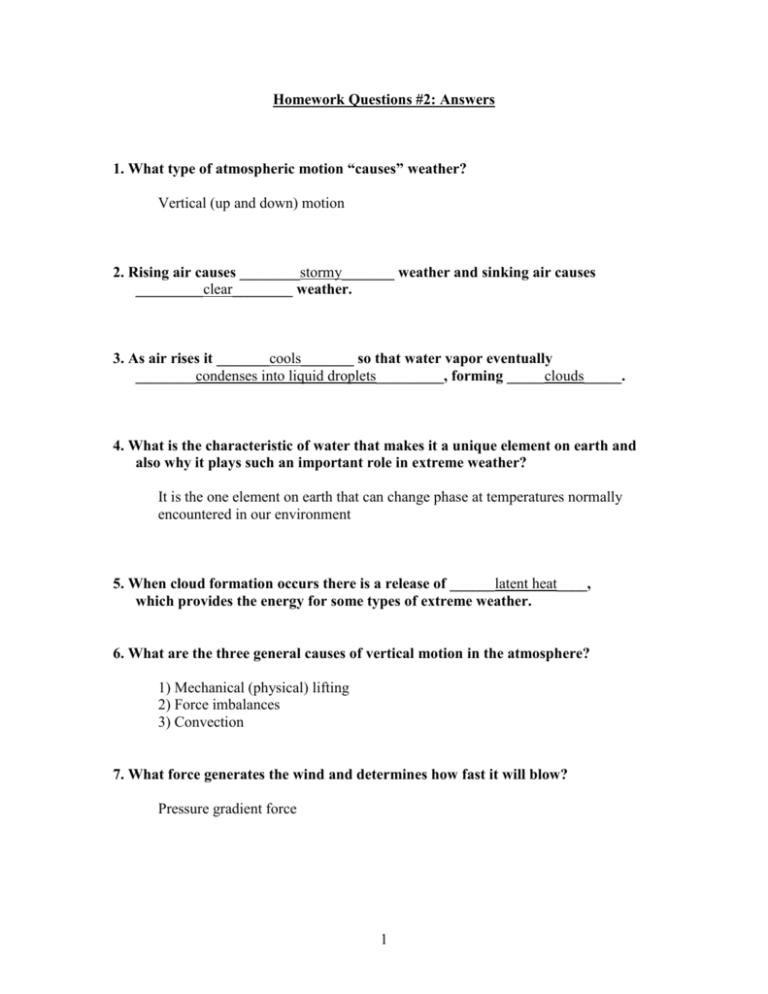
Homework Questions #2: Answers 1. What type of atmospheric motion “causes” weather? Vertical (up and down) motion 2. Rising air causes ________stormy_______ weather and sinking air causes _________clear________ weather. 3. As air rises it _______cools_______ so that water vapor eventually ________condenses into liquid droplets_________, forming _____clouds_____. 4. What is the characteristic of water that makes it a unique element on earth and also why it plays such an important role in extreme weather? It is the one element on earth that can change phase at temperatures normally encountered in our environment 5. When cloud formation occurs there is a release of ______latent heat____, which provides the energy for some types of extreme weather. 6. What are the three general causes of vertical motion in the atmosphere? 1) Mechanical (physical) lifting 2) Force imbalances 3) Convection 7. What force generates the wind and determines how fast it will blow? Pressure gradient force 1 8. Coriolis force is an ______apparent (not real)_______ force that exists due to ____earth’s spherical shape and rotation_________. 9. Coriolis force only changes ______the direction of motion of air (wind direction) not its _____speed______. 10. What are the two forces that are generally in balance (in a horizontal plane; called geostrophic balance) above earth’s surface? Pressure gradient force and Coriolis force 11. Because of this balance (#10) wind flows ____counter-clockwise___ around low pressure systems (cyclones) and ________clockwise________ around high pressure systems (anticyclones). 12. What is a jet stream? A relatively narrow band of strong horizontal winds that encircles the earth at upper portions of the troposphere in midlatitudes 13. At what level of the atmosphere are the winds in a jet stream the strongest? At or just below the tropopause 14. What type of “gradient” between the tropics and the poles results in the pressure differences that creates jet streams and determines how strong the winds in them will be? Temperature gradient 15. Which type of extreme weather, extratropical cyclones or tropical cyclones (hurricanes) are associated with jet streams? Extratropical cyclones 16. _________Divergence________ at the tropopause results in removal of air from the atmospheric column leading to upward motion in the troposphere and eventual development of surface low pressure. 2 17. Where, relative to a “trough” in the jet stream, is a surface low pressure system most likely to develop. (Identify this location in a wave diagram like the one I drew in class) ↑ North A D B C ↓ South Most likely to develop to the east of the “trough”. This would be “D” in the diagram 18. What is the additional force, only present to a significant degree at earth’s surface, that results in convergence into a surface low pressure system to complete the vertical circulation associated with these systems? Friction 19. A surface ____low_____ pressure system is a cyclone and a surface ____high____ pressure system is an anticyclone. (see note packet 2, V A and B, p. 13) 20. Winds flow ______counterclockwise____ around a cyclone and ____clockwise___ around an anticyclone in the Northern Hemisphere. (see note packet 2, V A and B, p. 13) 21. Fronts are boundaries between ___air of different density__. The boundary between cold air to the north and warm air to the south in midlatitudes along which the jet stream and ECs form is called the ____polar____ front. 3 22. As an EC develops, the counterclockwise circulation around the surface low generates smaller-scale fronts, mainly _____cold______ fronts extending to the west of the low and ____warm_____ fronts extending to the east of the low. 23. A cold front is represented on a surface weather map as a __blue line with triangles__ and a warm front is represented as a ______red line with semicircles________. 24. Cold front’s have a ____steep_____ slope which causes the precipitation to fall in a _______narrow_______ band. 25. a) Precipitation caused by a cold front is most frequently in the form of __rain__. b) Why? Because the precipitation is occurring in the warm air being lifted by the front. 26. Compared to cold fronts, warm fronts have a __more gradual__ slope and they move at a ____slower____ speed which is why the precipitation associated with a warm front tends to cover a ____larger____ area and be of lighter intensity than a cold front. 27. With a winter EC, as one moves from north to south relative to a warm front the precipitation transitions from ______snow______ to ______sleet_______ to _____freezing rain_______ to _____rain________. 28. Dry lines act like cold fronts and lift air as they move east because ___dry___ air is heavier than ___moist___ air. 29. What type of extreme weather is associated with dry lines? Severe thunderstorms 30. Where (geographically) are dry lines most common? Tornado alley (southern U.S. Great Plains) 4
